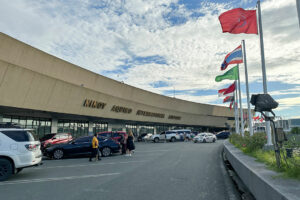By Ashley Erika O. Jose, Reporter
SAN MIGUEL-LED New NAIA Infrastructure Corp. (NNIC), the new operator of the country’s main gateway, will now start collecting higher landing and take-off fees from airlines, the Department of Transportation (DoTr) said.
“The increase is actually high. It is almost double, but the rates — the last increase was in the year 2000 — so for the last 24 years, there have been no increases in fees that were charged at the airport,” Transportation Secretary Jaime J. Bautista said on the sidelines of the European Chamber of Commerce of the Philippines Aviation Summit 2024 on Wednesday.
Landing and take-off fees are charges levied for the use of airport facilities and services during aircraft landings and takeoffs.
Mr. Bautista said that the imposition of higher landing and take-off fees is effective Oct. 1, or at least 15 days after the official turnover of the operations and maintenance of NAIA to its private operator.
NNIC took over the operations and maintenance of the Philippines’ main airport on Sept. 14.
“The proposed revised fees, dues, charges and assessments for the use of the properties, facilities and services of the NAIA by the Airport Operator were approved through Cabinet Resolution No. 01 Series of 2024,” the Manila International Airport Authority (MIAA) said.
The imposition of higher landing and take-off fees does not necessarily mean that airfares will increase, Mr. Bautista said, adding that airlines have the option to absorb the higher fees or pass on the charges.
“The airlines won’t certainly like it, but I don’t think it would result in higher airfares since the take-off and landing fees are comparatively smaller compared the other operations and maintenance costs of running an airline,” Nigel Paul C. Villarete, senior adviser on PPP at the technical advisory group Libra Konsult, Inc., said via Viber.
BusinessWorld reached out to Philippine carriers for comments but has not received a response as of press time.
Under MIAA’s Revised Administrative Order No. 1, series of 2024, landing and take-off fees for international air traffic movement will be increased in a gradual manner within NNIC’s concession period.
For landing and take-off fees for international operations, an aircraft will be charged a minimum rate of $794, effective after one year.
Currently, aircraft weighing up to 50,000 kilograms will pay a fee of $2.48 per 500 kilograms, while those weighing 50,001 to 100,000 kilograms will pay a minimum rate of $248.12 or $3.11 per 500 kilograms or fraction thereof beyond 50,000.
Meanwhile, for domestic operations, an aircraft weighing up to 50,000 kilograms will be charged a minimum fee of P15,417 effective one year after the operations and maintenance contract.
For now, airlines with aircraft operating domestic operations will be charged P48.18 per 500 kilograms which will be increased to P154.17 after one year.
Further, an aircraft weighing 50,001 to 100,000 kilograms will be charged a minimum rate of P4,817.80 or P60.11 per 500 kilograms.
NNIC is also set to collect higher passenger service charges starting September 2025, Mr. Bautista said.
“All fee adjustments were pre-determined and set by the government and its financial adviser for the Public-Private Partnership project, the Asian Development Bank,” NNIC said.
Passenger service charges, also known as terminal fees, are imposed on departing passengers.
Currently, domestic travelers pay a passenger service charge of P200, while foreign travelers pay P550. It is anticipated that these fees will rise to P390 and P950, respectively.
In March, the NNIC, formerly SMC SAP & Co. Consortium, signed a P170.6-billion contract to operate, maintain, and upgrade the country’s primary gateway for 25 years.
The NNIC plans to construct a new passenger terminal building with a capacity of 35 million passengers annually, as part of efforts to alleviate airport congestion.
The government anticipates earning P900 billion from the project, equating to P36 billion per year. This figure is 20 times larger than the P1.17 billion annually remitted by the MIAA over the 13 years through 2023, according to the DoTr.
